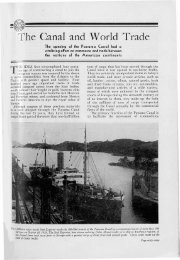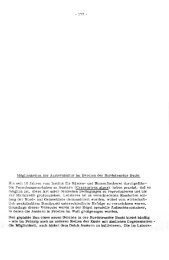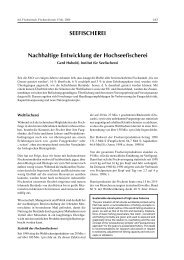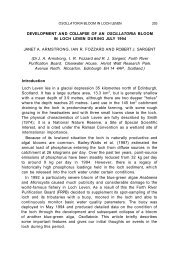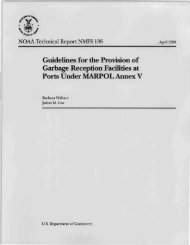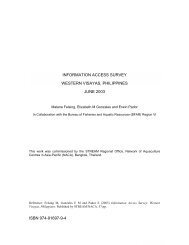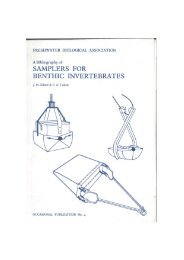The Economic Importance Of Marine Angler Expenditures In
The Economic Importance Of Marine Angler Expenditures In
The Economic Importance Of Marine Angler Expenditures In
Create successful ePaper yourself
Turn your PDF publications into a flip-book with our unique Google optimized e-Paper software.
U.S. results<br />
<strong>The</strong> $14.6 billion in retail purchases by saltwater anglers<br />
in the U.S. in 2000 9 generated a total of $30.5 billion in<br />
sales as follows: $13.0 billion in sales for the direct sectors<br />
($17.5 billion was transferred to out-of-country producers<br />
of goods and services purchased in the U.S.), $6.7<br />
billion in sales for the indirect sectors, and $10.9 billion<br />
in sales from households purchasing goods and services<br />
(induced impacts; Table 146). <strong>Angler</strong> expenditures in<br />
the U.S. also generated a total of $12.0 billion in personal<br />
income and supported approximately 349,119 jobs.<br />
Approximately 11% of the angler dollars spent in the<br />
U.S. impacted the economies of other countries. <strong>Of</strong><br />
the $14.6 billion spent by residents of the U.S. on retail<br />
goods and services, $13.0 billion (89%) directly affected<br />
the U.S. economy (Table 146); $1.6 billion in goods<br />
and services were imported into the U.S. in response<br />
to angler demands. Thus, on average, about 89 cents of<br />
every dollar spent in the U.S. by recreational fishermen<br />
remained in the country in 2000. <strong>The</strong> amount lost to<br />
other countries can be calculated from the difference<br />
between the total impact expenditures and direct impacts<br />
(Table 147).<br />
Boat maintenance/expenses was the single most<br />
important angler expense category in generating sales,<br />
income, and jobs in the U.S. Nationwide, expenditures<br />
on boat maintenance/expenses generated over $7.1<br />
billion in sales, $3.4 billion in income, and supported<br />
approximately 91,000 jobs (Tables 147–149). Boat purchases<br />
also contributed significant sales, income, and<br />
employment impacts to all of the states, as did new fishing<br />
vehicles, rods and reels, and lodging expenditures.<br />
<strong>The</strong> impacts created by anglers fishing from private<br />
boats and from the shore were higher than those produced<br />
from party/charter boat fishing in the U.S.<br />
Federal taxes generated by angler purchases were approximately<br />
$3.1 billion (Table 151). Revenues received<br />
by state/local governments were approximately $1.8 billion.<br />
<strong>In</strong> total, angler expenditures in the U.S. generated<br />
tax revenues of $4.9 billion in 2000.<br />
Discussion<br />
Nationwide, recreational saltwater fishing generated<br />
over $30.5 billion in sales in 2000, nearly $12.0 billion<br />
9 Total expenditures by resident anglers in the U.S. in 2000 approached<br />
$22.6 billion. However, that estimate of expenditures<br />
did not distinguish between purchases made at the retail level and<br />
those made through household-to-household sales. Household-tohousehold<br />
sales of merchandise are considered transfer payments<br />
from one household to another and generate no economic impacts.<br />
<strong>The</strong>refore, in this paper, we removed those household-tohousehold<br />
sales associated with used boats and vehicles prior to<br />
generating economic impacts.<br />
in income, and supported nearly 350,000 jobs. To place<br />
the study results in context relative to the total income<br />
and employment generated in the U.S. in 2000, marine<br />
recreational fishing expenditures accounted for less<br />
than 0.2% of the total income and employment that<br />
existed in the nation.<br />
<strong>In</strong> general, the impacts generated from private/rental<br />
boat and shore fishing exceeded the impacts generated<br />
from party/charter boat fishing. Additionally, at<br />
a state-level, resident angler impacts were higher than<br />
non-resident angler impacts across all of the coastal<br />
U.S. states in this study. This disparity is generally due<br />
to higher overall effort and hence expenditures by<br />
residents. Although average expenditures were similar<br />
between residents and non-residents across most of the<br />
states, resident participants outnumbered non-residents<br />
by almost two to one and fished over three times as many<br />
days as non-residents (Steinback and Gentner, 2001).<br />
<strong>The</strong> actual effect of angler expenditures on a state’s<br />
economy depends upon the level of imports necessary<br />
to supply the goods and services anglers’ purchase.<br />
<strong>The</strong> level of imports required at the state-level ranged<br />
from a high of 66% in Rhode Island to a low of 20%<br />
in Georgia. <strong>In</strong> contrast, on a national level only about<br />
11% of all goods and services purchased by anglers were<br />
imported in 2000.<br />
An interesting result emerged in the NE that illustrates<br />
how imports affect the amount of economic activity that<br />
remains within a region. <strong>The</strong> highest sales, income, employment,<br />
and tax impacts across the NE coastal states<br />
were generated in New Jersey, even though recreational<br />
fishing expenditures in Maryland and Massachusetts<br />
were greater. This was because a higher proportion of<br />
the goods and services required to satisfy angler demands<br />
were imported into Maryland and Massachusetts<br />
than into New Jersey. According to the data contained<br />
within IMPLAN, the infrastructure that supports angler<br />
purchases in New Jersey was more extensive than the<br />
other coastal states in the NE. Results show that, on average,<br />
64 cents of every dollar spent on marine fishing<br />
supplies and services remained within New Jersey. This<br />
amount declined to 52 cents in Maryland and 48 cents<br />
in Massachusetts. <strong>The</strong> majority of the difference can be<br />
attributed to angler purchases of boat fuel and gasoline<br />
for their automobiles. Refineries and distributors operating<br />
within the state supplied approximately 87% of<br />
the gasoline purchased in New Jersey. 10 <strong>In</strong> the remain-<br />
10 <strong>The</strong> level of imports necessary to meet angler demands for each expenditure<br />
category can be calculated from the difference between<br />
the total impact expenditure and the direct impact in the second<br />
table for each state. <strong>In</strong> New Jersey, for example, $5.09 million in<br />
imports of boat fuel were required to meet the purchasing demands<br />
of anglers ($38.98 million–$33.89 million; Table 39). Thus,<br />
approximately 87% (33.89/38.98) of the boat fuel purchased by<br />
anglers in New Jersey was refined and distributed within the state.<br />
7



